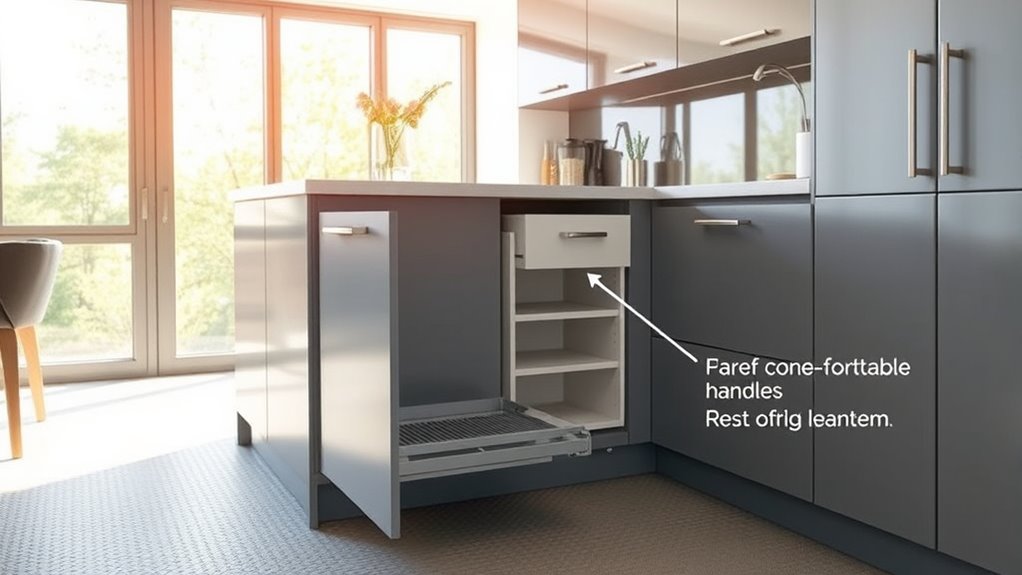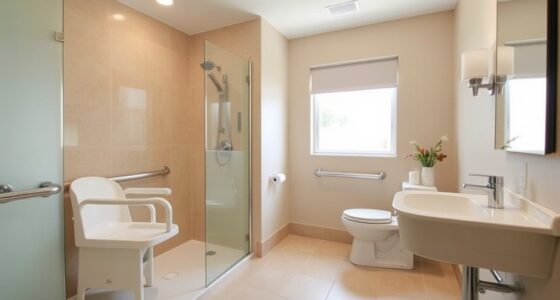To improve your kitchen’s accessibility, incorporate pull-out shelves and drawers to reach items easily without stretching or climbing. Adjustable lifts and counter heights let you customize work surfaces for comfort and safety, especially for changing needs or multiple users. Good lighting and smart layout optimize visibility and reduce hazards. Small adjustments like these make everyday tasks smoother and safer—if you want practical tips tailored for real use, there’s much more to explore.
Key Takeaways
- Incorporate pull-out shelves and drawers to easily access items at the back without bending or stretching.
- Use adjustable-height counters and lifts to customize workspace for comfort and safety for all users.
- Install bright, under-cabinet, and motion-activated lighting to enhance visibility and reduce accidents.
- Optimize layout by placing frequently used items within easy reach and maintaining open, clutter-free pathways.
- Focus on safety and ease of use with reach zones, pull-outs, and lifts to create a functional, enjoyable kitchen for everyone.

Kitchen Accessibility
A well-designed kitchen should be accessible to everyone, regardless of physical ability or age. When planning your space, focus on features that make everyday tasks easier and safer. Pull-out shelves and drawers can transform your storage experience, allowing you to reach items at the back without straining or risking spills. Instead of bending or stretching awkwardly, you simply slide out a shelf and access what you need. This not only saves time but reduces the risk of accidents, especially if you have mobility issues or arthritis. Incorporating simple tips for thriving plants and pest-free gardens can inspire you to create a more inviting and comfortable environment overall.
Lifts and adjustable-height counters are game-changers. With a touch of a button or a simple turn, you can raise or lower a work surface to suit your height or task. This flexibility is especially useful if multiple people use the kitchen or if your needs change over time. Imagine preparing a meal at a comfortable height, avoiding the strain on your back or shoulders. These lifts can also be used for appliances or sinks, making them more accessible and easier to use without awkwardly stretching or kneeling.
Reaching is another critical aspect of accessible kitchen design. Installing pull-down shelves or cabinet drawers within easy reach ensures you don’t have to climb or stretch to access your essentials. Use lower cabinets for frequently used items, and consider installing pull-out baskets or organizers that bring everything to you. This minimizes the effort required to access utensils, pots, or pantry staples. When storage is within your natural reach, you’ll find cooking and cleaning less cumbersome and more enjoyable.
Lighting also plays a vital role. Well-placed, bright lighting reduces shadows and makes it easier to see what you’re doing, especially when reaching into tight corners or low cabinets. Motion-activated lights or under-cabinet lighting can be especially helpful, providing illumination exactly where you need it without having to fumble around switches.
Finally, consider the overall layout. An open, uncluttered space with wide pathways allows for easy movement, whether you’re steering with a walker, wheelchair, or just carrying groceries. Position frequently used items at waist level, and keep countertops clear of unnecessary clutter. These simple adjustments make your kitchen more functional, helping you perform daily tasks comfortably and confidently. When you incorporate pull-outs, lifts, and thoughtful reach zones, your kitchen becomes a space you’ll not only use but enjoy—safe, efficient, and tailored to your needs.
Frequently Asked Questions
What Is the Average Cost of Installing Kitchen Accessibility Features?
You can expect to spend around $1,500 to $5,000 on installing kitchen accessibility features. Costs vary depending on the specific upgrades, like pull-outs, lifts, or lowered countertops. Basic modifications such as adjustable shelves or simple ramps tend to be more affordable, while full-scale renovations or high-tech lifts can raise the price. Planning your budget ahead helps ensure you choose the right features without overspending.
Are There DIY Options for Making a Kitchen More Accessible?
Yes, you can DIY some kitchen accessibility upgrades. For example, install lower shelves or pull-out drawers yourself, which makes items easier to reach. You can also add lever-style handles to cabinets and faucets for easier grip. Painting or applying non-slip tape to floors improves safety. Just guarantee you follow safety guidelines and use proper tools. For major modifications, consider consulting a professional to avoid potential issues.
How Long Does It Take to Install Pull-Out Shelves or Lifts?
It typically takes a few hours to install pull-out shelves or lifts, depending on your kitchen’s size and complexity. If you’re doing it yourself, set aside 2 to 4 hours to measure, assemble, and install each unit carefully. For professional installation, expect it to take about the same amount of time, but it might be quicker since experts are experienced. Make sure to have the right tools and instructions on hand to speed things up.
Can These Accessibility Features Be Added to Existing Kitchens?
While it’s often easier to plan for accessibility features during a remodel, you can definitely add pull-outs, lifts, and reach mechanisms to your existing kitchen. The process varies depending on your space and needs, but professionals can customize solutions to fit your current setup. Expect some adjustments and minor renovations, but with the right expert, your kitchen can become more accessible without a full overhaul.
What Are the Maintenance Requirements for Accessibility Equipment?
You need to regularly clean and inspect your accessibility equipment to keep it functioning properly. Wipe down pull-outs, lifts, and reach mechanisms to prevent dust and debris buildup. Check moving parts for wear and lubricate as needed. Look for loose screws or damaged components and tighten or replace them promptly. Scheduling annual professional maintenance can help identify issues early, ensuring your equipment remains safe and reliable for everyday use.
Conclusion
By incorporating pull-outs, lifts, and reach features, you transform your kitchen into an accessible haven where everyone can cook and gather comfortably. These upgrades are like magic wands, turning a challenging space into a seamlessly functional one. Don’t settle for a kitchen that limits you—embrace these solutions and open a world of independence. With these modifications, you’ll be amazed at how effortlessly your kitchen adapts to your needs, making everyday moments feel truly extraordinary.









